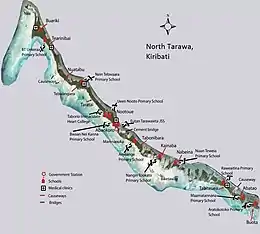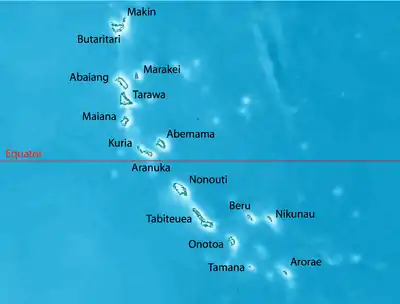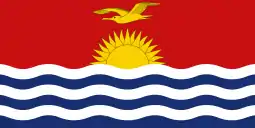North Tarawa
North Tarawa or in Gilbertese Tarawa Ieta, in the Republic of Kiribati, is the string of islets from Buariki at the northern tip of Tarawa atoll to Buota in the South, with a combined population of 6,629 as of 2015. It is administratively separate from neighbouring South Tarawa, and is governed by the Eutan Tarawa Council (ETC), based at Abaokoro.
 Map of North Tarawa | |
 | |
| Geography | |
|---|---|
| Location | Pacific Ocean |
| Coordinates | 1°26′N 173°00′E |
| Archipelago | Gilbert Islands |
| Area | 15.26 km2 (5.89 sq mi) |
| Highest elevation | 3 m (10 ft) |
| Administration | |
| Demographics | |
| Population | 6,629 (2015 Census) |
| Pop. density | 400/km2 (1000/sq mi) |
| Ethnic groups | I-Kiribati 99.7% |
| Official name | Nooto-North Tarawa |
| Designated | 4 March 2013 |
| Reference no. | 2143[1] |
Geography
North Tarawa has a land area of 15.26 km2. It is made up of several islets; the widest part of North Tarawa can be found in the village of Buariki and the narrowest width in the village of Tearinibai, next to Buariki.[2]
Buota was joined by a bridge to South Tarawa in 1995 and has since increased in population and is becoming more like part of urban South Tarawa. Abatao is not accessible by road, but the channel can be easily walked at low tide and there is a boat service at high tide. For people in Abatao and Buota, it is much easier to access schools, clinics and other services on South Tarawa than to travel to the Government Station in Abaokoro.[3] Apart from the bridge from Buota to Tanaea, small causeways connect the villages of Tebwangoroi and Taratai, Tebwangoroi and Nuatabu.[3] The erosion and accretion that are occurring along the shoreline is identified as being linked to aggregate mining, land reclamation and the construction of causeways that has been thought to change the currents along the shoreline.[4]
The atoll has a protected area that is designated as the North Tarawa Conservation Area.[5]
Villages
Abaokoro accommodates the main service infrastructures such as the offices of Eutan Tarawa Council, the junior secondary school and the main medical centre. With the rapid growth of population in South Tarawa, people are choosing to settle in North Tarawa in greater numbers, especially in Abatao and Buota, the two villages closest to South Tarawa.[2]
There are 14 villages in North Tarawa. From North to South, the villages and their populations are:
| North Tarawa: Places and population | |||
| Village | 2000[6] | 2005[7] | 2010[8] |
|---|---|---|---|
| Buariki | 533 | 597 | 703 |
| Tearinibai | 221 | 317 | 297 |
| Nuatabu | 183 | 199 | 197 |
| Tebwangaroi | 34 | 34 | 40 |
| Taratai | 179 | 203 | 151 |
| Nooto | 699 | 845 | 814 |
| Abaokoro | 248 | 294 | 262 |
| Marenanuka | 70 | 71 | 101 |
| Tabonibara | 227 | 300 | 363 |
| Kainaba | 149 | 219 | 266 |
| Nabeina | 297 | 414 | 435 |
| Tabiteuea | 342 | 391 | 505 |
| Abatao | 379 | 421 | 499 |
| Buota | 916 | 1,373 | 1,469 |
| North Tarawa total | 4,477 | 5,678 | 6,102 |
Economy
In North Tarawa, the subsistence lifestyle practiced throughout the Gilbert Islands coexists with a more market economy based on trade with neighboring South Tarawa. Only 16% of the workforce are in paid employment, but a further 17% earn cash from market oriented activities. There is a strong trade in local food, building materials and other items from North Tarawa, which are sold for cash in markets and on the streets of South Tarawa.[3]
Education
Aratokotoko Primary School is in North Tarawa.[9] The Japanese government funded the construction of four classrooms there, spending $95,004.00 U.S. dollars (about $92,505.00 Australian dollars).[10]
Currently there is one Christian senior high, Immaculate Heart College.[11]
Myths and legends
North Tarawa has a special place in Kiribati mythology; the tree of life or tree of knowledge or Uekera was planted in Buariki village in North Tarawa by Nei Tekanuea. Uekera came from the south. Spirits who lived in a tree in Samoa migrated northward carrying branches from the tree.[4] It was these spirits, together with Nareau the Wise who created the islands of Tungaru (the Gilbert Islands)[Note 1]
History
Tarawa was governed as one island, under a king, until Colonial times. The colonial administrative centre of Kiribati was originally located at Taratai in North Tarawa (where the last king used to live). The administrative centre was later moved to South Tarawa, which remains the capital of Kiribati to this day. The decision to locate the Government on South Tarawa led to many changes; the lifestyle on South Tarawa is now almost urban, while lifestyles on North Tarawa remain based in traditional, subsistence culture.[14]
In the early 1970s, a boat constructed at Taratai village was sailed to Fiji using traditional navigation techniques, as part of a project led by James Siers to demonstrate that Pacific seafarers were capable of making deliberate voyages of exploration in ancient times.[15]
Visiting North Tarawa
Transport
There are regular ferry services from urban South Tarawa to the main villages of North Tarawa, and it is also relatively simple to charter a boat. The road from South Tarawa ends at the channel between Buota and Abatao, but this channel can be easily walked at low tide, so that the southern islets of North Tarawa can be accessed on foot.
Accommodation
The Island Council operates a guest house at Abaokoro, providing basic accommodation for Government workers and other visitors, but also welcoming tourists. There are also several independent homestays and lodges in North Tarawa.[16]
Notes
- Sir Arthur Grimble, cadet administrative officer in the Gilberts from 1914 and resident commissioner of the Gilbert and Ellice Islands colony from 1926, recorded the myths and oral traditions of the Kiribati people. He wrote the best-sellers A Pattern of Islands (London, John Murray 1952,[12] and Return to the Islands (1957), which was republished by Eland, London in 2011, ISBN 978-1-906011-45-1. He also wrote Tungaru Traditions: writings on the atoll culture of the Gilbert Islands, University of Hawaii Press, Honolulu, 1989, ISBN 0-8248-1217-4.[13]
References
- "Nooto-North Tarawa". Ramsar Sites Information Service. Retrieved 25 April 2018.
- "North Tarawa Island Report 2012". Government of Kiribati.
- "5. North Tarawa" (PDF). Office of Te Beretitent - Republic of Kiribati Island Report Series. 2012. Retrieved 28 April 2015.
- Dr Temakei Tebano & others (March 2008). "Island/atoll climate change profiles - Tarawaieta (North Tawara)". Office of Te Beretitent - Republic of Kiribati Island Report Series (for KAP II (Phase 2). Archived from the original on November 6, 2011. Retrieved 28 April 2015.
- Edward R. Lovell, Taratau Kirata & Tooti Tekinaiti (September 2002). "Status report for Kiribati's coral reefs" (PDF). Centre IRD de Nouméa. Retrieved 15 May 2015.
- "Kiribati Census 2010". Secretariat of the Pacific Community. July 2012. Retrieved 9 March 2013.
- Kiribati 2005 census of population and housing.
- "Kiribati Census Report 2010 Volume 1" (PDF). National Statistics Office, Ministry of Finance and Economic Development, Government of Kiribati. Archived from the original (PDF) on 10 August 2014. Retrieved 17 March 2013.
- "Grant Assistance for Grassroots Human Security Projects (GGP)." Embassy of Japan in the Republic of Fiji (在フィジー日本国大使館). Retrieved on July 9, 2018.
- "Japan Assists Aratokotoko Primary School, Kiribati." Embassy of Japan in the Republic of Fiji (在フィジー日本国大使館). 26 February 2012. Retrieved on 9 July 2018.
- "TABITEUEA NORTH 2008 Socio-Economic Profile" Part 2 of 4. Strengthening Decentralized Governance in Kiribati Project , Ministry of Internal and Social Affairs (Kiribati). p. 48 (PDF p. 13/15). Part 1 is here.
- Grimble, Arthur (1981). A Pattern of Islands. Penguin Travel Library. Penguin Books. ISBN 0-14-009517-9.
- Grimble, Arthur (1989). Tungaru traditions: writings on the atoll culture of the Gilbert Islands. Penguin Travel Library. University of Hawaii Press. ISBN 978-0-8248-1217-1.
- North Tarawa Socioeconomic Report 2008. Secretariat of the Pacific Community and Government of Kiribati
- Siers, James (1978). Taratai - a Pacific adventure. Millwood Press. ISBN 0908582005.
- "Kiribati Tourism Accommodation Guide". Government of Kiribati. Archived from the original on 2013-03-20. Retrieved 2013-03-15.
